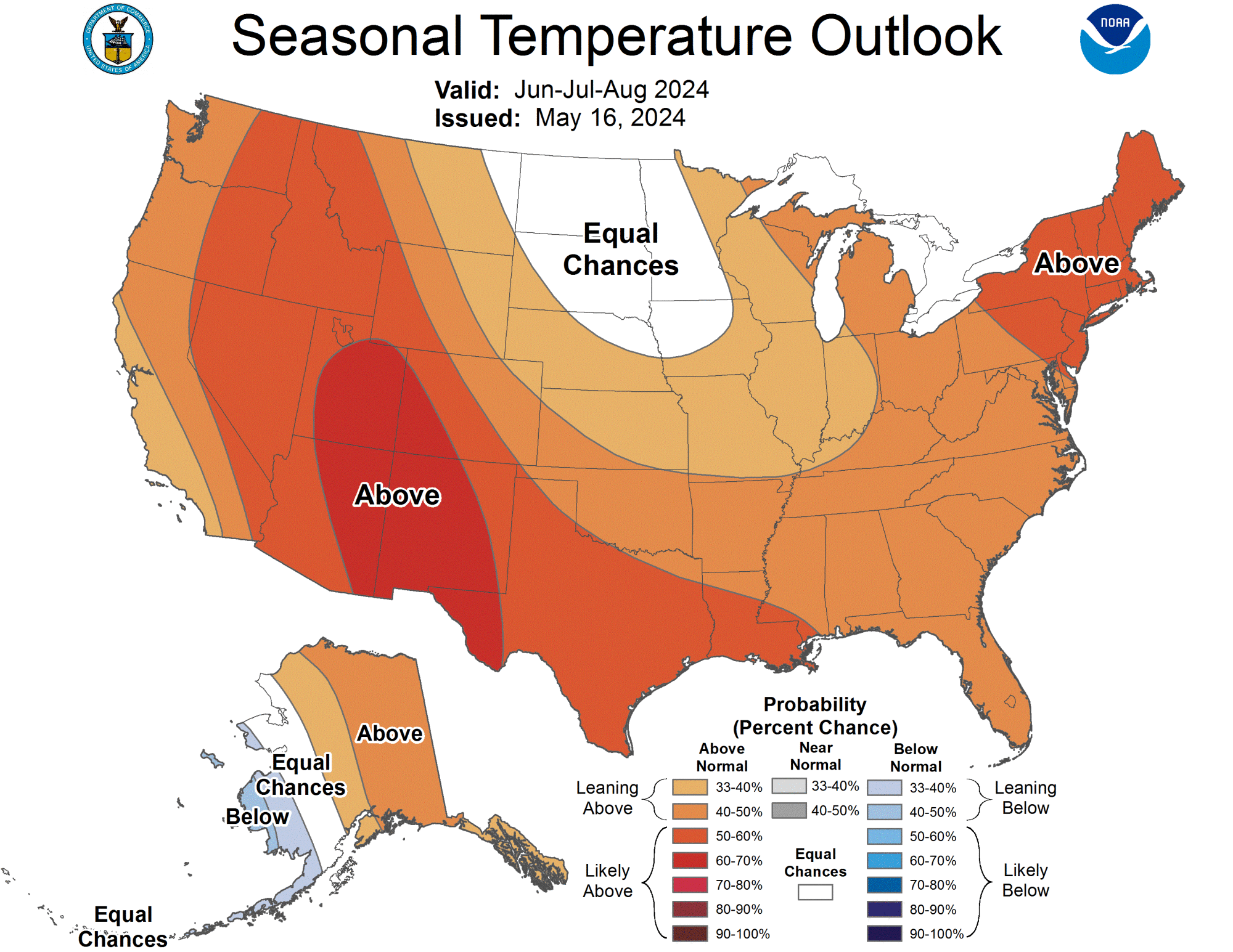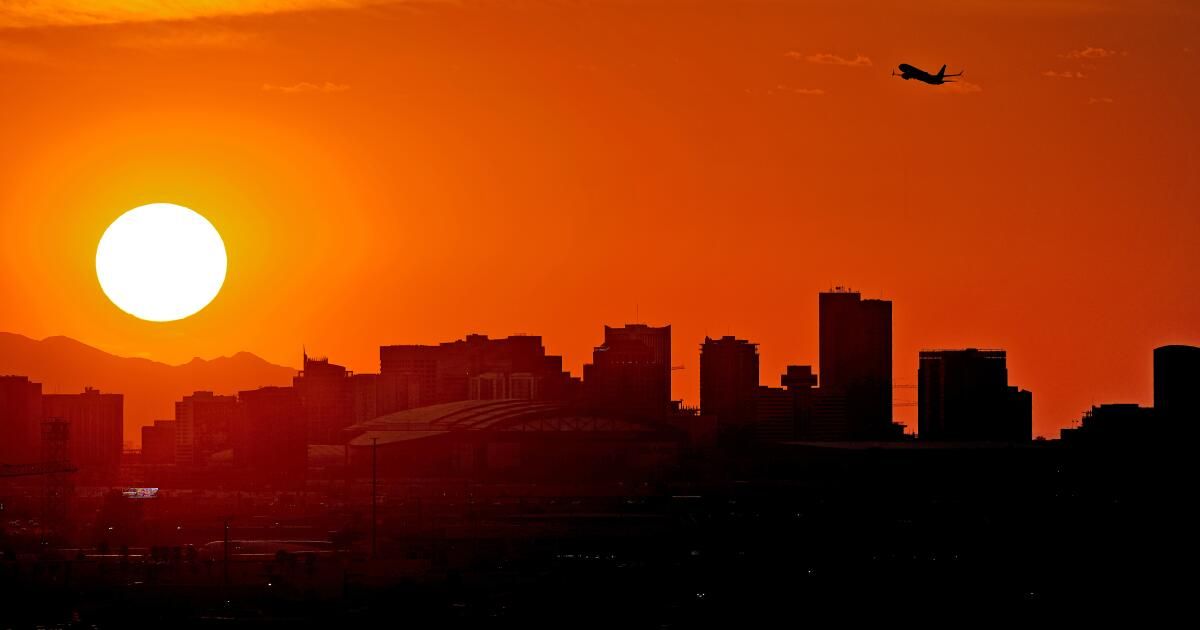A major early-season heat wave heading toward western North America threatens to bring sweltering temperatures that could break records. Here, a plane rises over Phoenix during a period of extreme heat in July 2023.
(Matt York/Associated Press)
A major early-season heat wave heading toward western North America threatens to bring sweltering temperatures that could break records, prime the landscape for wildfires and usher in a sizzling summer.
A powerful high-pressure ridge, or heat dome, will bring unusually high temperatures to the Golden State by the middle of this week before spreading into the Pacific Northwest and southwestern Canada, according to UCLA climate scientist Daniel Swain. Temperatures could remain well above normal across much of the region for 10 to 14 days.

Aggressive and impactful reporting on climate change, the environment, health and science.
The warmest parts of California will not be the inland desert regions that typically experience high temperatures, but rather parts of Northern California and the Sierra Nevada foothills, Swain said during a briefing Friday. The Sacramento Valley could see widespread triple-digit temperatures, including over 110 degrees in the central and northern valley for Wednesday and Thursday, up to 20 degrees above normal.
“This will be another event where a good portion of the California population (those near the coast in the Bay Area and Southern California) will likely not see extreme heat,” Swain said. “But you may not need to go that far inland to see dramatically higher temperatures, and if you go far enough inland, you may even see record-breaking heat.”
Far northern California is likely to experience its first 100-degree day of the year on Wednesday, according to the National Weather Service. The Central Valley is under an excessive heat watch, with chances of reaching 110 degrees in the San Joaquin Valley.
The event bears some similarity to a record heat dome that covered the Pacific Northwest for 27 days in June and July 2021, although it will be smaller in magnitude, Swain said. That event generated numerous studies and research papers, and was associated with hundreds of deaths, mass die-offs of marine life, loss of crops, and damage to infrastructure.
The 2021 heat dome also intensified the 2021 fire season, a pattern that could repeat itself this year.
Although California has enjoyed two relatively mild fire seasons thanks to back-to-back wet winters, it has seen an explosion of new vegetation that can heal with incoming heat, creating fuel for future flames. The state has already seen several small fires, including a 1,300-acre fire in Santa Barbara County.
“There is no real indication of extreme fire risk with this pattern, but it will set the stage for more rapid drying of vegetation in June after a couple of wet winters, and could potentially accelerate wildfire conditions later in the season.” “Swain said.
The incoming heat could also be the death knell for the rest of the state's snowpack, which has dropped to about 44% of normal for this time of year after peaking in April. The melt will not cause flooding, but could cause rivers to rise and cool, a potential danger to swimmers seeking relief from high temperatures, according to the weather service.
While the worst effects of the heat wave could dissipate by mid-June, it could also usher in a long, hot summer, forecasters said.
The latest seasonal temperature forecast from the National Oceanic and Atmospheric Administration indicates that June, July and August will bring above-normal temperatures across nearly all of the United States, with the highest likelihood of warmer-than-usual conditions in the Four Corners region. from Arizona. , New Mexico, Colorado and Utah.

NOAA's latest seasonal outlook indicates a high probability of warmer than normal temperatures across most of the U.S. in June, July and August.
(National Oceanic and Atmospheric Administration)
In California, the odds favor above-normal temperatures across the state, most likely further inland.
Last year, Arizona made headlines when Phoenix suffered a record 31-day streak of temperatures of 110 degrees or higher. In Death Valley, the mercury rose to 128 degrees, just shy of the all-time world record.
Dan Collins, a meteorologist at NOAA's Climate Prediction Center and author of the latest seasonal forecast, said the coming summer will be heavily influenced by changes in the El Niño-La Niña cycle, as well as climate change.
“These seasonal outlooks are largely due to those two factors,” he said.
El Niño, a weather pattern in the tropical Pacific, has been a factor in record temperatures around the world since its arrival last year. April marked the 11th consecutive month of record global temperatures, and 2023 was the hottest year on record on the planet.
Although El Niño has weakened, it has still influenced boiling tropical ocean temperatures that are driving atmospheric circulation patterns, including the incoming heat wave, Collins said.
But part of the reason the West is expected to experience an abnormally warm season is climate change, which has driven an overall warming trend in the region over recent decades.
“El Niño may have contributed to warmer global temperatures, but of course there was also a long-term temperature trend,” Collins said.
The incoming heat wave also won't be the first notable heat event this year. Several Florida cities have broken daily records in recent weeks, including 97 degrees in Tampa and Orlando, and 96 degrees in Miami and West Palm Beach. Heat indices (measurements that include temperature and humidity) were several degrees higher.
The heat has also smothered parts of the Caribbean, Central America and Mexico, where temperatures in Oaxaca soared to a record 118.4 degrees on May 26. Some parts of Mexico are also suffering from extreme drought, with officials warning that Mexico City will soon run out of water.
Extreme heat is one of the deadliest effects of climate change, and heat in Mexico has already been associated with more than 60 deaths this year. The Phoenix heat wave last year killed at least 645 people, while the Pacific Northwest heat wave in 2021 is believed to have contributed to at least 600 deaths, including many in homes without air conditioning.
Collins said the incoming heat wave has the potential to not only produce record daytime temperatures, but also record nighttime temperatures.
“Actually, it's not just that summer is coming as planned,” he said. “It is an extreme event that is planned.”
UCLA's Swain said there are still some uncertainties about how the heat wave will play out in the western United States, in part because it could last until mid-June. But what is clear is that it will be very hot for millions of people.
“These are pretty high temperatures,” he said. “These are some important numbers.”
Newsletter
Towards a more sustainable California
Get Boiling Point, our newsletter exploring climate change, energy and the environment, and be part of the conversation and the solution.
You may occasionally receive promotional content from the Los Angeles Times.












